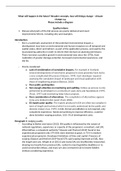What will happen in the future? Broader concepts, how will things change – climate
change e.g.
Please include a diagram
Quality/reform
1. Discuss what parts of the EIA process are poorly delivered and need
improvement/reform, including why and examples.
Introduction
- EIA is a systematic assessment of the potential environmental impacts a
development may have on environmental and human receptors on all temporal and
spatial scales, direct and indirect, as part of the application process, and used by the
local planning authority in order to inform their decision on planning permission.
There has been a positive growth in environmental laws since the 1970s, from
realization of greater damage potential, increased environmental awareness, and
the EU.
- Poorly considered:
o Lack of consideration of cumulative impacts. For example in Scotland,
several developments of wind farms proposed in close proximity have led to
a very complicated EIA process (Glasson, 1999). Each developer required
assessing the cumulative impact of landscape and visual application with
those of neighboring projects (Benson, 2003)
o Poor public participation
o Not enough attention on monitoring and auditing. Follow-up process is only
performed by developers in a minority of cases (Arts and Nootebloom 1999).
(Frost, 1997) said monitoring helps future projects.
o Poor consideration of alternatives. The compilation of alternatives appears
to be very limited in EIA report (Tesli, 2002).
o ES reports poor quality. The reports produced in EIA are often too complex in
term of length and technical which is not easily understood by the public and
decision makers (Lee, 1995). In EIA, formal accreditation is not required, only
competent experience. Needs streamlining to improve efficiency, could be
done by better scoping practices. 0.01-1% of development costs.
o
Paragraph 1: Judging quality
- According to Barker and Jones (2013), EIA quality is influenced by the nature of
national regulations, experience or capacity of the proponent, consultant, and LPA.
What defines a competent authority? Glasson and Therivel (2019) found in low
experienced proponent only 27% EIAs were deemed as good, vs 71% in medium
experienced proponents. Developer limitations of time and capital. Presence of
scoping (Glasson and therivel 2019 found 67% said scoping improved an EIA). Also
the length and cost, Wright et al (2013) said many EIAs are insufficiently researched,
drawing too heavily from previous EIAs, rushed to meet legislative deadlines or to
avoid construction delays, and many are also contracted out to lowest bidders
without considering experience.





